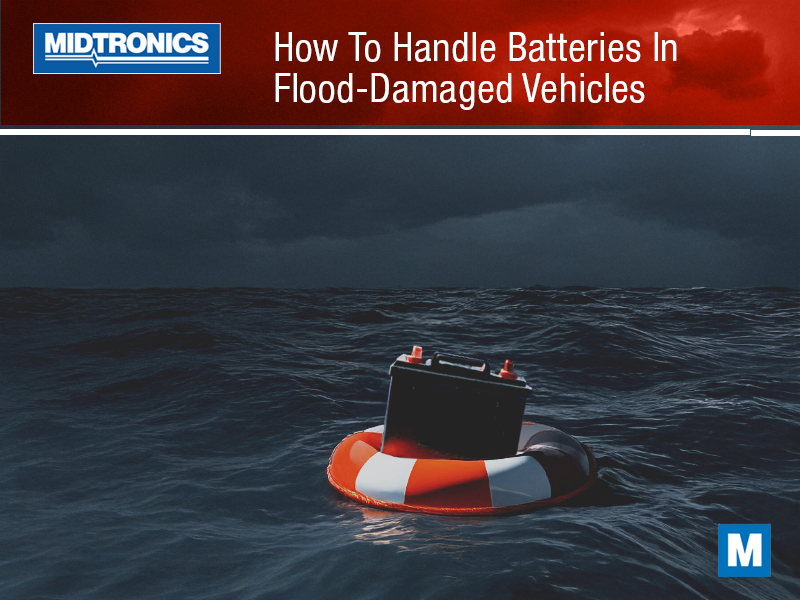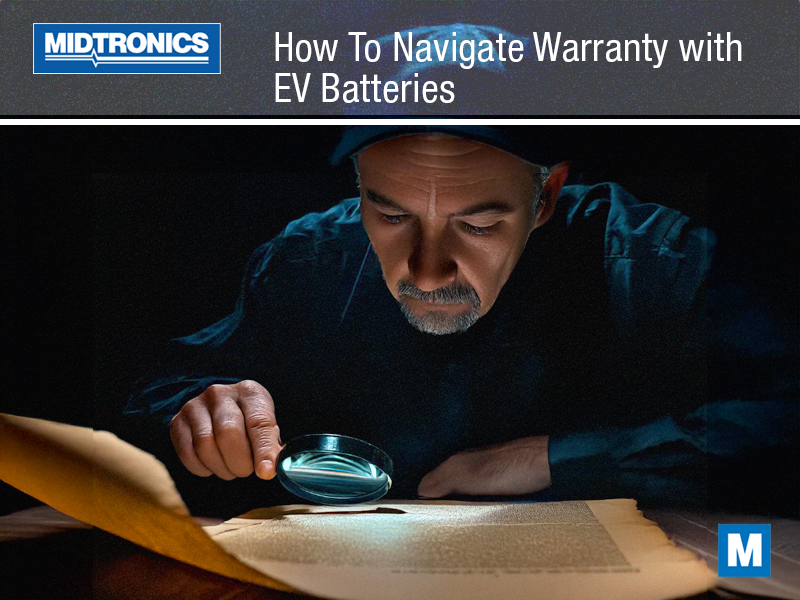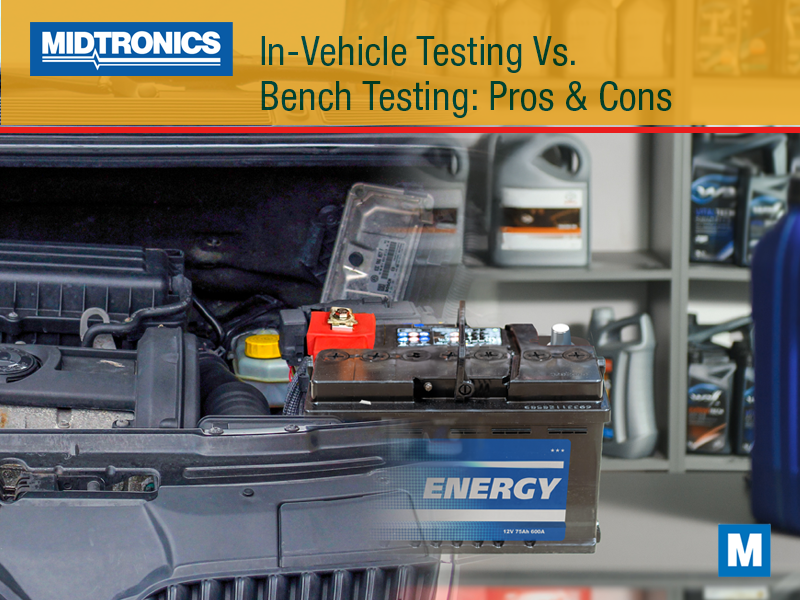In recent years, extreme weather events and flooding have seemed to become increasingly common, both in the United States and worldwide. With these events comes a surge in vehicles damaged by floodwaters. For anyone in the repair industry, the aftermath includes a growing need to address the specific problems posed by flood-damaged batteries. Whether you’re dealing with a standard 12V lead-acid battery, a lithium-ion battery, or a high-voltage EV battery, knowing how to handle, assess, and repair them safely is crucial.
Learn what happens to batteries exposed to floodwaters, how to identify signs of damage, and the best practices for decommissioning and repairing them.
What Happens to Batteries in Floodwater
Floodwaters can devastate batteries, just like many other parts. It’s no secret that electrical devices and water aren’t a match made in heaven. The specific effects vary depending on the type of battery, but the combination of water exposure and contamination can create widespread damage.
For Lead Acid Batteries
For 12V lead-acid batteries, water exposure can lead to terminals and connector corrosion. Over time, corrosion interferes with conductivity, making it harder for the battery to perform efficiently. The battery’s electrolyte may also become diluted or contaminated by floodwater if you aren’t dealing with a sealed battery. It’s the least reactive of the battery types, though.
For Other Chemistries
12V lithium-ion batteries, commonly found in hybrid and electric vehicles plus some high-end models, react differently to flood exposure. While some lithium-ion batteries are housed in sealed enclosures, prolonged water exposure or submersion can degrade the seal, and that’s when the trouble gets serious.
When water enters the battery, it can lead to internal short circuits, cell instability, or even thermal runaway, a dangerous condition where the battery overheats and potentially catches fire. Corrosion can also damage the battery’s external connections, further impacting its ability to function.
For High Voltage Batteries
High-voltage EV batteries are generally protected well by their enclosures, and in multiple levels. However, these enclosures are not immune to damage, particularly in situations where seals have been compromised by debris or prolonged submersion. Water inside a high-voltage battery can damage its cells, cause chemical leaks, or like Li-ion 12V batteries, the potential for fire with thermal runaway – but with much more energy to release. Even without visible damage, these batteries may retain dangerous levels of electrical energy, making proper handling and testing critical.
Signs a Battery Has Been in a Flood
Identifying flood damage is the first step in determining whether a battery can be salvaged or must be replaced.
For 12V lead-acid batteries, the damage is often visible:
- Corrosion around the terminals or connectors is a common sign
- A swollen or distorted casing is also typical
- In some cases, the electrolyte may appear discolored or have an unusual odor, pointing to contamination or leakage.
Lithium-ion batteries may also show signs of damage, although they can be less obvious than with lead-acid batteries:
- A swollen or bloated battery case is a clear indicator of internal damage
- Any evidence of burn marks or discoloration caused by overheating
- Corrosion on the case, seams, connections or any other external parts
High-voltage EV batteries present unique challenges, as the damage is often internal and not immediately visible. Water stains or debris around the battery housing can suggest a breached seal. In many cases, the onboard diagnostic system or battery management system will provide error codes or warning lights, signaling that something is wrong. Also, an unusual increase in heat during operation or charging can indicate water damage.
How to Deal with Batteries That Have Been Flooded
Once you’ve identified that a battery has been exposed to floodwater, handling it correctly is essential. The process begins with de-energizing and progresses to testing, reconditioning, or replacement, depending on the extent of the damage.
De-energizing a flood-damaged battery starts with safety. Always wear appropriate personal protective equipment including gloves and goggles to protect against corrosive materials and potential electrical hazards. Before touching the battery, verify that it’s safe to handle using a multimeter or diagnostic tool to confirm there is no residual energy that could cause a shock. For HV batteries, use equipment like the GRX-5100 Battery Service Tool to discharge the battery pack.
After ensuring the battery is safe, perform a thorough visual inspection. Look for external damage such as corrosion, swelling, or signs of leaking. For EV batteries, pay close attention to the condition of the enclosure and any signs of water ingress. In many cases, advanced diagnostic tools, like those from Midtronics, are invaluable for assessing the internal health of the battery without opening it up.
Testing flood-damaged batteries helps to understand their condition. For lead-acid batteries, diagnostic equipment can measure voltage, capacity, and overall state of health. For lithium-ion and high-voltage EV batteries, testing may involve evaluating cell balance, voltage consistency, and insulation integrity. These tests should always be performed with specialized equipment and by trained personnel with EV certifications.
Reconditioning a battery that has been exposed to floodwater is sometimes an option, particularly for lead-acid models. This can involve cleaning corrosion or recharging the battery under controlled conditions. However, reconditioning lithium-ion and EV batteries is more complex and often not recommended. In many cases, replacing these batteries is a safer and more practical solution.
When replacing a flood-damaged battery, make sure the old battery is handled responsibly and recycled safely. Install the new battery according to the manufacturer’s specifications and test the system after installation. This is especially critical for EV batteries where any faults can lead to significant safety issues.
To Sum It Up
Flood-damaged vehicles are becoming a more common challenge for repair shops, and batteries are among the most critical and potentially hazardous components to address. Whether you’re dealing with a 12V lead-acid battery, a lithium-ion battery, or a high-voltage EV battery, knowing how to safely identify, test, and handle flood damage should be something every shop is aware of. Handling these batteries requires careful discharging, accurate testing, and appropriate decisions about repair or replacement.
Midtronics offers industry-leading equipment that helps technicians work efficiently and confidently, even with complex cases like flooded EV batteries. Equip your shop with the best tools to handle every challenge and keep your customers’ vehicles running safely.




